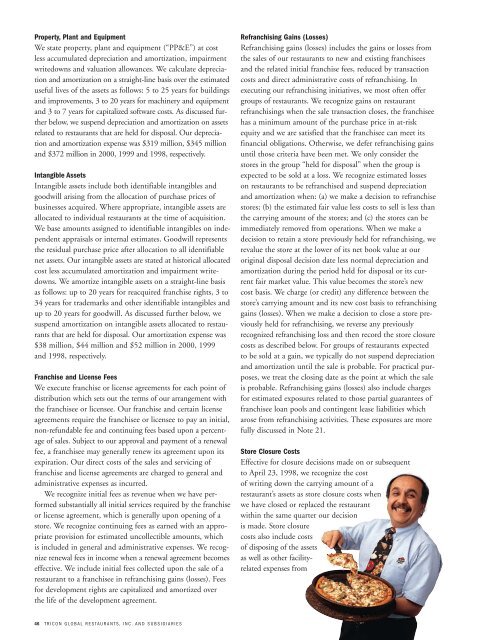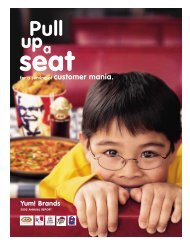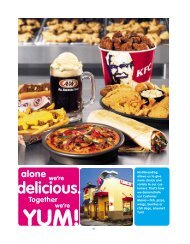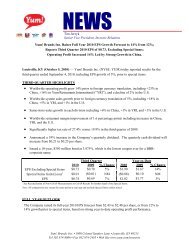2000 Annual Report - Yum!
2000 Annual Report - Yum!
2000 Annual Report - Yum!
Create successful ePaper yourself
Turn your PDF publications into a flip-book with our unique Google optimized e-Paper software.
Property, Plant and Equipment<br />
We state property, plant and equipment (“PP&E”) at cost<br />
less accumulated depreciation and amortization, impairment<br />
writedowns and valuation allowances. We calculate depreciation<br />
and amortization on a straight-line basis over the estimated<br />
useful lives of the assets as follows: 5 to 25 years for buildings<br />
and improvements, 3 to 20 years for machinery and equipment<br />
and 3 to 7 years for capitalized software costs. As discussed further<br />
below, we suspend depreciation and amortization on assets<br />
related to restaurants that are held for disposal. Our depreciation<br />
and amortization expense was $319 million, $345 million<br />
and $372 million in <strong>2000</strong>, 1999 and 1998, respectively.<br />
Intangible Assets<br />
Intangible assets include both identifiable intangibles and<br />
goodwill arising from the allocation of purchase prices of<br />
businesses acquired. Where appropriate, intangible assets are<br />
allocated to individual restaurants at the time of acquisition.<br />
We base amounts assigned to identifiable intangibles on independent<br />
appraisals or internal estimates. Goodwill represents<br />
the residual purchase price after allocation to all identifiable<br />
net assets. Our intangible assets are stated at historical allocated<br />
cost less accumulated amortization and impairment writedowns.<br />
We amortize intangible assets on a straight-line basis<br />
as follows: up to 20 years for reacquired franchise rights, 3 to<br />
34 years for trademarks and other identifiable intangibles and<br />
up to 20 years for goodwill. As discussed further below, we<br />
suspend amortization on intangible assets allocated to restaurants<br />
that are held for disposal. Our amortization expense was<br />
$38 million, $44 million and $52 million in <strong>2000</strong>, 1999<br />
and 1998, respectively.<br />
Franchise and License Fees<br />
We execute franchise or license agreements for each point of<br />
distribution which sets out the terms of our arrangement with<br />
the franchisee or licensee. Our franchise and certain license<br />
agreements require the franchisee or licensee to pay an initial,<br />
non-refundable fee and continuing fees based upon a percentage<br />
of sales. Subject to our approval and payment of a renewal<br />
fee, a franchisee may generally renew its agreement upon its<br />
expiration. Our direct costs of the sales and servicing of<br />
franchise and license agreements are charged to general and<br />
administrative expenses as incurred.<br />
We recognize initial fees as revenue when we have performed<br />
substantially all initial services required by the franchise<br />
or license agreement, which is generally upon opening of a<br />
store. We recognize continuing fees as earned with an appropriate<br />
provision for estimated uncollectible amounts, which<br />
is included in general and administrative expenses. We recognize<br />
renewal fees in income when a renewal agreement becomes<br />
effective. We include initial fees collected upon the sale of a<br />
restaurant to a franchisee in refranchising gains (losses). Fees<br />
for development rights are capitalized and amortized over<br />
the life of the development agreement.<br />
46 TRICON GLOBAL RESTAURANTS, INC. AND SUBSIDIARIES<br />
Refranchising Gains (Losses)<br />
Refranchising gains (losses) includes the gains or losses from<br />
the sales of our restaurants to new and existing franchisees<br />
and the related initial franchise fees, reduced by transaction<br />
costs and direct administrative costs of refranchising. In<br />
executing our refranchising initiatives, we most often offer<br />
groups of restaurants. We recognize gains on restaurant<br />
refranchisings when the sale transaction closes, the franchisee<br />
has a minimum amount of the purchase price in at-risk<br />
equity and we are satisfied that the franchisee can meet its<br />
financial obligations. Otherwise, we defer refranchising gains<br />
until those criteria have been met. We only consider the<br />
stores in the group “held for disposal” when the group is<br />
expected to be sold at a loss. We recognize estimated losses<br />
on restaurants to be refranchised and suspend depreciation<br />
and amortization when: (a) we make a decision to refranchise<br />
stores; (b) the estimated fair value less costs to sell is less than<br />
the carrying amount of the stores; and (c) the stores can be<br />
immediately removed from operations. When we make a<br />
decision to retain a store previously held for refranchising, we<br />
revalue the store at the lower of its net book value at our<br />
original disposal decision date less normal depreciation and<br />
amortization during the period held for disposal or its current<br />
fair market value. This value becomes the store’s new<br />
cost basis. We charge (or credit) any difference between the<br />
store’s carrying amount and its new cost basis to refranchising<br />
gains (losses). When we make a decision to close a store previously<br />
held for refranchising, we reverse any previously<br />
recognized refranchising loss and then record the store closure<br />
costs as described below. For groups of restaurants expected<br />
to be sold at a gain, we typically do not suspend depreciation<br />
and amortization until the sale is probable. For practical purposes,<br />
we treat the closing date as the point at which the sale<br />
is probable. Refranchising gains (losses) also include charges<br />
for estimated exposures related to those partial guarantees of<br />
franchisee loan pools and contingent lease liabilities which<br />
arose from refranchising activities. These exposures are more<br />
fully discussed in Note 21.<br />
Store Closure Costs<br />
Effective for closure decisions made on or subsequent<br />
to April 23, 1998, we recognize the cost<br />
of writing down the carrying amount of a<br />
restaurant’s assets as store closure costs when<br />
we have closed or replaced the restaurant<br />
within the same quarter our decision<br />
is made. Store closure<br />
costs also include costs<br />
of disposing of the assets<br />
as well as other facilityrelated<br />
expenses from














